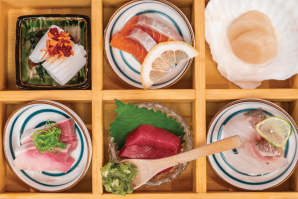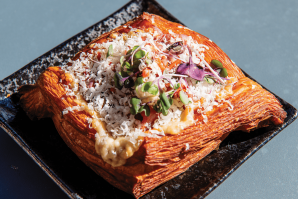A $100,000 mochi-making machine her father bought in Japan in 1990 has been sitting in Linda Nakatani’s garage for 20 years. Designed to make the process easier, it can crank out 3,000 mochi in an hour. However, Nakatani, who took over the Japanese sweet shop Osaka-Ya after her father’s passing in 2009, decided not to use it. “It doesn’t look right,” she says, referring to the mochi produced by the equipment. Instead, Nakatani (who can make about 500 pieces per hour depending on the type of mochi) and her sons, Yoshi and David Murakami, continue to make each mochi by hand.
The history of mochi dates back more than 2,000 years, evolving from an unsweetened, whole-grain snack into the pillowy, chewy glutinous rice dessert we know today. Osaka-Ya has a rich history of its own. In a YouTube clip shown at the 2022 Burnett Award ceremony by the Sacramento History Museum — an award Nakatani received — city historian Marcia Eymann said the confectionery was established around 1910, though some believe it was founded in 1903. Since then, the shop has changed ownership several times, surviving Japanese internment and Sacramento’s urban redevelopment, which demolished the city’s historic Japantown to make way for Capitol Mall. Nakatani says her father’s friend’s father gave Osaka-Ya to her mother in 1963.
Mochi, one of many Japanese desserts, can also be enjoyed in savory dishes like yakimochi (grilled mochi) and has been reimagined into ice cream, donuts, coffee and waffles. As of 2023, the mochi market is valued at $282.68 billion and is projected to reach $638.6 billion by 2031. Research indicates that health-conscious consumers are attracted to its gluten-free, vegan and low-sugar varieties.
Chew on this
Today, Osaka-Ya is the only dedicated Japanese mochi and manju shop in Sacramento. Nakatani ships orders to the Bay Area and other states, such as Denver, upon request. When asked why there are so few mochi shops, Nakatani says, “it’s a lot of work.” Everything at Osaka-Ya is homemade. “Nothing is instant,” she adds. For example, the entire process of preparing raw red beans to make anko, the sweet filling for mochi, manju, breads or pancakes, takes eight hours. During the New Year, one of their busiest days, they work around the clock.
Osaka-Ya in Sacramento offers various flavors of mochi and other
Japanese confections.

Now semi-retired, Nakatani trains Yoshi, 23, and David, 25, in the art of making traditional Japanese treats, preparing them to take over the business when she fully retires. Despite the labor-intensive process of pounding and shaping the mochi, they remain committed to maintaining tradition. “Don’t cut corners,” Nakatani says, who began visiting her parents’ shop at age 6, started making mochi at 12 and made partner at 24. “Do it the way Grandma did it.” Nakatani also says she has never worked anywhere else.
Nakatani says both sons have chosen not to take a salary. She says they’re proud of their heritage and want to keep the family business going. Initially, David considered pursuing a different career, but after seeing Yoshi help out, he joined in and discovered that he and his brother work well together. Although mochi will remain an iconic staple for years to come thanks to her sons, Nakatani acknowledges the need to modernize flavors and introduce new products to appeal to younger generations. She says David often approaches her with new ideas, saying, “Let’s try this; let’s do it this way.”
Cult favorite
While Osaka-Ya preserves mochi-making traditions through painstaking craftsmanship, another beloved spot in Sacramento has quietly risen to fame for its equally meticulous approach to Japanese baked goods. The delicate aroma of freshly baked sweet and savory yeasted breads fills the air at Mahoroba Japanese Bakery, an unassuming octagonal dome-shaped building in South Land Park. The staff often fill the customers’ trays with heaps of packaged Japanese morning treats. Owner and pastry maker Narusuke Monguchi, who opened the shop in 2009, begins baking as early as 1 a.m. and often stays well after the bakery closes at 2 p.m.
Mahoroba’s Berry Berry pastry features blueberry whipped cream
with custard cream, blueberries and strawberries.

In an interview with The Sacramento Bee, Monguchi said in Japanese, “I don’t sleep much. Many Americans want their food quickly, but it takes time to make good bread. You divide the dough into small pieces, let it rise and repeat the process. It takes five hours.” Much like Nakatani, who also discusses the physically demanding nature of creating high-quality treats, he takes great joy in sharing Mahoroba’s products with Sacramentans and tourists.
At Mahoroba, cult favorites include the Kobe cream delight, a round bread filled with homemade custard cream, and bacon and egg baked on top of a dough. Other savory options are pizza and curry meatball breads. Sweet choices include the strawberry anko cream bread filled with red bean, whipped cream and a fresh strawberry.
Cool cat
Japanese flavors are now influencing the creations of ambitious pastry chefs across the Capital Region. One standout example is Thai American pastry chef Nariya Charoensupaya, who left her comfortable positions at bakeries and restaurants nearly five years ago to open her own Asian-inspired cottage-licensed pop-up bakery, the Pastry Cat. Her sweets shop is renowned for three signature cookies: miso brown butter, gluten- and dairy-free matcha yuzu almond and salted Valrhona chocolate chip.
Since moving to Sacramento from the Bay Area in 2019, she has collaborated with Scorpio Coffee and Majka Pizzeria. These days, she can be found at the recently opened Offbeat Coffee on most Saturdays from 9 a.m. to noon or until the items sell out, whichever comes first. There, you may find her originals along with oolong tea brownie, lap cheong (a Chinese-style sausage) and cheese scone, black sesame and citrus sable and yuzu almond croissant. Her menu rotates, so expect something new each week.
“My products are a reflection of who I am and what I want my customers to experience,” Charoensupaya said in an interview with Palo Alto Online. “Although I was trained primarily in French pastry techniques, I love incorporating Asian-inspired flavors into my products, as that is what I truly enjoy and what I grew up with.”
These three entrepreneurs don’t only all have Japanese flavors in common; they also all exemplify selfless giving. Nakatani says she remains responsive to customer orders even while on vacation, and on one occasion, she shortened her recovery time after surgery to meet demand.
During the pandemic, Nakatani recalls preparing lunch boxes and stocking essential ingredients that older Japanese individuals who were unable to travel might need. Despite having to discard 500 pieces of manju each day during COVID-19, she continued to make them fresh in case customers wanted them. Nakatani says people often tell her, “Time is money” and question why she invests so much effort. “You can’t look at your time as work,” Nakatani says. “I just have to do it. Where else are they going to get mochi?”
–
Stay up to date on business in the Capital Region: Subscribe to the Comstock’s newsletter today.
Recommended For You

Omakase Reimagined
The Japanese tasting menu concept is branching out to other cuisines
Omakase has evolved from a Japanese culinary tradition mostly associated with high-end sushi restaurants to a dining concept that accommodates a wide range of palates.

Pop-Up Popularity
Female chefs and bakers find success outside the traditional restaurant model
These nomadic eateries, which surged in popularity around the Great Recession, came in vogue again during the COVID-19 pandemic, often as the only option for cooks in lockdown.

From Baker’s Stats to Stanzas: Jim Franks’ ‘Existential Bread’ Launches in Davis
Picking apart the stuff (seeds, stories, hoaxes) that go into what we think we know about bread
Baker and poet Jim Franks launched his experimental cookbook “Existential Bread” in Davis this week in collaboration with Student Collaborative Organic Plant Breeding Education, an interdisciplinary approach that offers a new way to consider our relationship with food and the complex processes and economics behind it.




